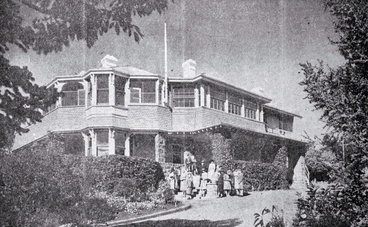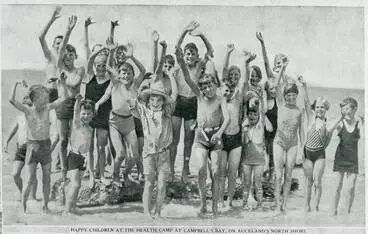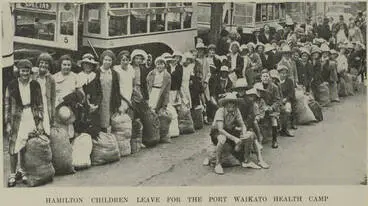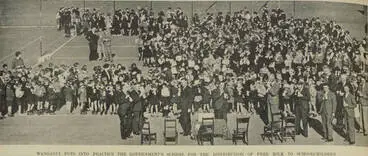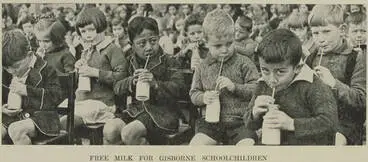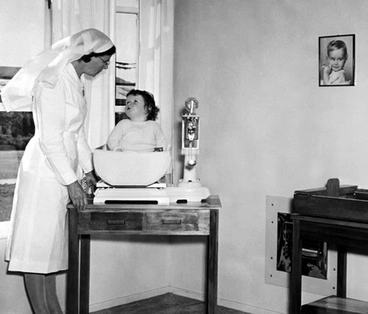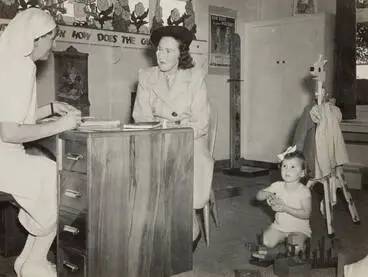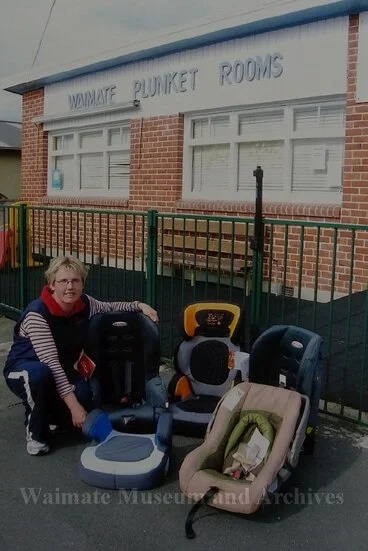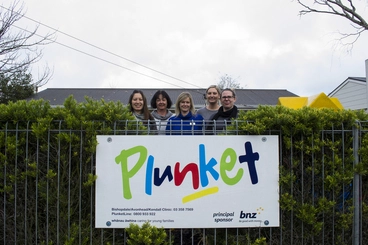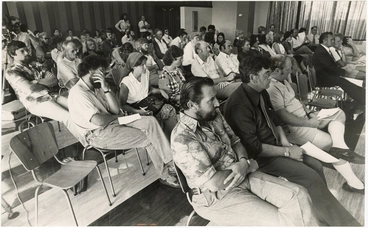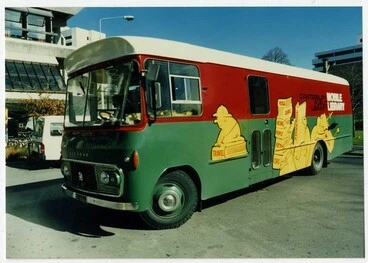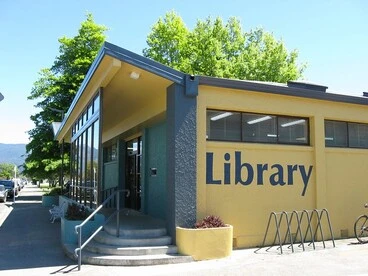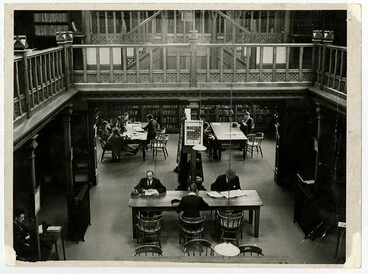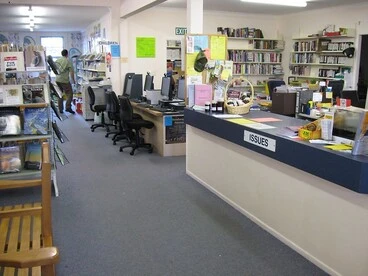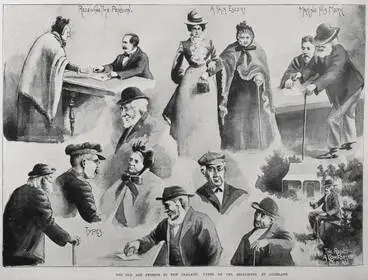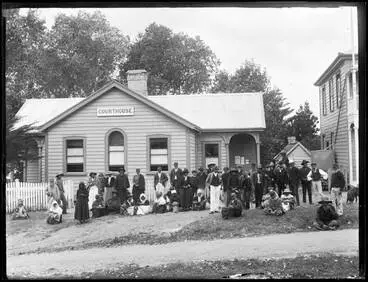A snapshot of state support in Aotearoa New Zealand
A DigitalNZ Story by National Library Services to Schools
This collection of images tells a story about historical state-funded support such as state housing, free hospital care, public libraries, free milk and health camps in Aotearoa New Zealand's history.
WELFARE BENEFITS
Before the 20th century there was no government support for families in financial difficulty. People who were unemployed or in need had to rely on relatives, their community, or charities.
Source: Family, welfare and Households — Family welfare, Te Ara — The Encyclopedia of New Zealand.
First Day Cover: New Zealand Health Stamps 1939
Canterbury Museum
STATE HOUSING
The first Labour government, elected in 1935, argued that only the state was able to fix the housing shortage. In 1936 it drew up plans to use private enterprise to build 5000 state rental houses across New Zealand. A new Department of Housing Construction oversaw building and the State Advances Department managed the houses. The initiative formed part of a wider plan to reduce unemployment and stimulate the economy.
Source: Events — First state house opened in Miramar, NZHistory.
Maori state house plans
Manatū Taonga, the Ministry for Culture and Heritage
State Housing at 139 Greys Avenue
Auckland Libraries
The first state house
Manatū Taonga, the Ministry for Culture and Heritage
Modified state house
Manatū Taonga, the Ministry for Culture and Heritage
State housing
Manatū Taonga, the Ministry for Culture and Heritage
Naenae state housing project
Manatū Taonga, the Ministry for Culture and Heritage
HEALTH CAMPS
By the late 1940s all New Zealand children had a medical examination on entering school, and were seen by a nurse at standards two and six. These examinations helped identify those who were not 'thriving' in their home environment. Malnourished children were sent to state-supported children's health camps, where they received health care and education. While these camps had been in existence since the early 20th century, they were mainly temporary and did not come under state control until 1938.
Source: Children and adolescents, 1930-1960 — Children's health, NZHistory.
Cod-liver oil time, Ōtaki Health Camp, 1945
Manatū Taonga, the Ministry for Culture and Heritage
Glenelg Health Camp on Murray-Aynsley Hill which was officially opened in April 1945
Christchurch City Libraries
Hamilton children leave for the Port Waikato Health Camp
Auckland Libraries
FREE MILK
New Zealand schoolchildren received free milk between 1937 and 1967. The first Labour government introduced the scheme – a world first – to improve the health of young New Zealanders (and make use of surplus milk).
Each day, milk monitors supplied a half-pint (284 ml) of milk to each pupil. By 1940 the milk was available to over 80 per cent of schoolchildren. For a few years during the Second World War, pupils also received an apple a day.
Source: Events — End of free school milk, NZHistory.
Auckland school children drinking the daily issue of free milk
Alexander Turnbull Library
Primary school boys drinking their school milk, Linwood, Christchurch
Alexander Turnbull Library
Inaugurating the school free milk scheme
Auckland Libraries
Free milk for Gisborne schoolchildren
Auckland Libraries
School children drinking their school milk, Linwood, Christchurch
Alexander Turnbull Library
PLUNKET
Dr Frederic Truby King helped form the Society for the Promotion of the Health of Women and Children at a meeting in Dunedin Town Hall.
The society, soon known as the Plunket Society after Lady Victoria Plunket, the wife of the governor and an ardent supporter, spread rapidly. Later that year, Plunket opened the first Karitane Home for Babies in Dunedin. A further six Karitane Hospitals were established to supplement home and clinic visits. These operated both as training bases for nurses and as care units for babies.
By 1909 there were Plunket Society branches in all four main centres. Sixty more branches opened following a lecture tour by King in 1912.
Source: Events — Plunket Society formed, NZHistory.
Plunket nurse weighing a baby
Manatū Taonga, the Ministry for Culture and Heritage
At play at Plunket, Auckland, 1947
Auckland Libraries
The first Plunket medal
Manatū Taonga, the Ministry for Culture and Heritage
Sharon Ronson with Plunket car seats
Waimate Museum and Archives
Staff, Kendal Avenue Plunket rooms
Christchurch City Libraries
Taradale Plunket Rooms war memorial
Manatū Taonga, the Ministry for Culture and Heritage
UNEMPLOYMENT
In the first quarter of the 20th century about 2% of the labour force said they were unemployed. Unfortunately the 1931 census was abandoned as a cost-saving measure, and the 1941 one was delayed until 1945 as a part of the war effort so it is unclear what happened over the middle period, although the unemployment rate was almost certainly above 10%, and perhaps above 20%, in the early 1930s. It was probably near zero during the war. Unemployment remained low during the post-war boom, but increased after the 1966 wool price collapse. It peaked in the early 1990s at above 10%. It fell through the next decade, but not to the low levels of earlier years.
Source: Economic history — Unemployment, 1896–2006, Te Ara — The Encyclopedia of New Zealand.
Unemployment meeting
Christchurch City Libraries
Unemployment demonstration outside parliament buildings
Alexander Turnbull Library
'Unemployed & Beneficiaries Hui' poster
Museum of New Zealand Te Papa Tongarewa
Unemployment benefit brochure
Manatū Taonga, the Ministry for Culture and Heritage
One pound Unemployment Relief stamp overprinted 'Specimen'
Museum of New Zealand Te Papa Tongarewa
FREE HEALTHCARE (HOSPITALS)
Robert Makgill was a key figure in the development of New Zealand's public health system. He became one of the country's first district health officers when the central government took on greater responsibility for public health. He was to play an important role during the 1918 influenza pandemic and its aftermath, notably as ‘the chief architect' of the ‘the most useful legacy of the 1918 influenza pandemic’, the 1920 Health Act.
Source: Images and media — Robert Makgill, NZHistory
Wellington - Wellington Free Hospital
Museum of New Zealand Te Papa Tongarewa
Karitane Hospital, Andersons Bay, Dunedin
Alexander Turnbull Library
Auckland Hospital, 1850s
Manatū Taonga, the Ministry for Culture and Heritage
Aerial view of Christchurch Hospital - Photograph taken by W G Weigel
Alexander Turnbull Library
New type of Wellington Free Ambulance, probably Wellington Region
Alexander Turnbull Library
Charitable aid
Manatū Taonga, the Ministry for Culture and Heritage
PUBLIC LIBRARY SERVICE
In the early 20th century a number of New Zealand communities established 'free' libraries with the assistance of Scottish-born American businessman and philanthropist Andrew Carnegie. In practice 'free' library services proved to be a lofty ideal which many communities struggled to meet, and others simply chose to ignore.
Source: New Zealand Library Week — New Zealand library stories, NZHistory.
Public computers, Shirley Library
Christchurch City Libraries
Canterbury Public Library Mobile Library
Christchurch City Libraries
Public Library in The Square
Palmerston North City Library
Motueka Library, Tasman District
Aotearoa People's Network Kaharoa
Canterbury Public Library interior
Christchurch City Libraries
Carterton Library Public PCs
Aotearoa People's Network Kaharoa
PENSIONS
The Act gave a small means-tested pension to elderly people with few assets who were ‘of good moral character’. Although Germany had earlier introduced a contributory state pension, New Zealand's was the first in the world funded from general taxation. It was one of the major achievements of Richard Seddon’s Liberal government.
The amount on offer was small. Applicants had to meet certain criteria to qualify for a pension of at most £18 per year (equivalent to $3400 in 2020). Only those with an annual income of £34 ($6400) or less and property valued at no more than £50 ($9500) received the full amount. Proof was required that the applicant was aged at least 65, which disadvantaged the many Māori whose births had not been registered. Applicants had to have lived in New Zealand for the previous 25 years; Chinese people were specifically excluded.
Source: Events — Old-age Pensions Act becomes law, NZHistory.
War Pensions Board, 1916
Manatū Taonga, the Ministry for Culture and Heritage
Collecting the pension
Manatū Taonga, the Ministry for Culture and Heritage
The old age pension in New Zealand: Types of the recipients in Auckland
Auckland Libraries
Denied the old age pension
Manatū Taonga, the Ministry for Culture and Heritage
Widows' pension, 1911
Manatū Taonga, the Ministry for Culture and Heritage
Pension claimants at Rawene Courthouse, 1899
Auckland Libraries
This story was curated and compiled by Te Puna Mātauranga o Aotearoa | National Library of New Zealand, Services to Schools staff, May 2022.
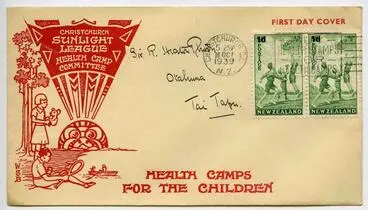

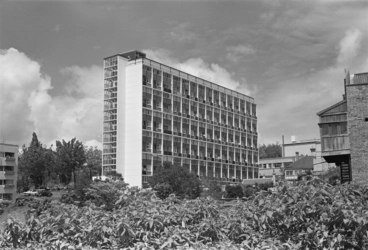




![For Children's Health Camps buy Health Stamps [poster] Image: For Children's Health Camps buy Health Stamps [poster]](https://thumbnailer.digitalnz.org/?resize=770x&src=https%3A%2F%2Fcollection.pukeariki.com%2Frecords%2Fimages%2Flarge%2F81517%2F1ce0a223a09990e6339066462b434bacf7063b2d.jpg&resize=368%253E)

